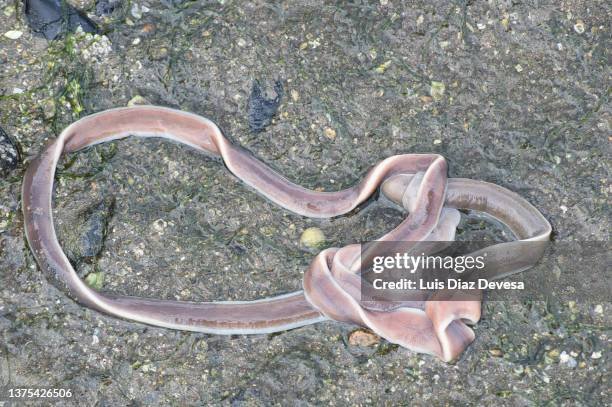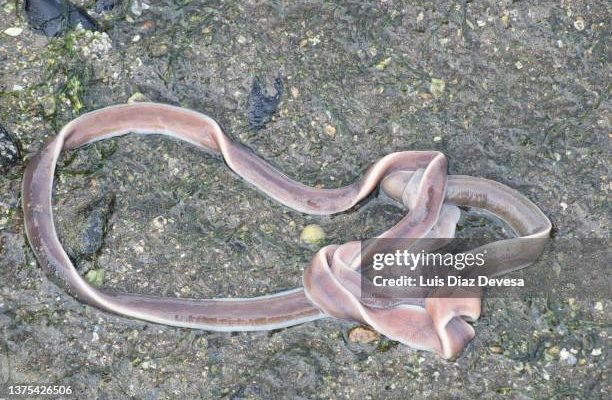
Ribbon worms, scientifically known as *Nemertea*, can be somewhat elusive. They often hide in the mud or sand, making them feel like the secret agents of the marine world. During low tide, their behaviors shift noticeably. Whether they’re foraging for food or trying to avoid predators, these worms have some smart strategies to make the most of their time on dry land. Let’s dive deeper into their unique behaviors and find out what they get up to when the tide goes low.
What Are Ribbon Worms?
You might be asking yourself, “What exactly is a ribbon worm?” Well, ribbon worms are soft-bodied, elongated worms that can vary in color from deep blues to bright pinks. These creatures can range from a few millimeters to several meters long. One of the most fascinating things about them is their body structure. Ribbon worms have a unique characteristic—a long, retractable proboscis, which they use to catch prey. Think of it like a stretchy tongue that can snag unsuspecting critters!
They typically dwell in marine environments, often found in sand or mud. These little guys are not just random inhabitants; they play a crucial role in the ecosystem. They help control populations of smaller organisms by feeding on them. During low tide, when their surroundings change dramatically, these behaviors become even more essential.
Why Low Tide Matters for Ribbon Worms
Low tide is like a double-edged sword for ribbon worms. On one hand, it exposes them to the elements, but on the other, it offers a chance to explore new areas. So, what’s the big deal about low tide? It’s all about accessibility. During this time, ribbon worms can venture into previously submerged zones, increasing their chances of finding food.
Here’s something to consider: when the tide goes out, the ribbon worms must adapt quickly. They need to avoid drying out while also ensuring they can hunt for food. This balancing act can be tricky. If they stay out of the water for too long, they risk desiccation, or drying out. So, they often wiggle back into the mud or sand to keep moist.
Feeding Habits During Low Tide
So, how do ribbon worms eat when the tide is low? Well, they’ve got a few tricks up their sleeves. Typically, these worms feed on a diet of small invertebrates, including crustaceans and other tiny sea creatures. When the water recedes, they can hunt along the tidal flats.
During low tide, ribbon worms use their proboscis to snag prey. Here’s the thing: they can be quite sneaky. They often bury themselves just below the surface, waiting for the perfect moment to ambush a passing critter. It’s a bit like fishing without a rod—using stealth and skill to catch dinner!
They also benefit from the increase in available food sources. With small creatures exposed in the shallow waters or mud, ribbon worms can feast more effectively than when they are completely submerged. It’s a buffet, and the ribbon worms are ready to dig in.
Movement and Behavior Changes
Let’s talk about how ribbon worms get around during low tide. You might think they can just slither along like a snake, but there’s more to it. When the water recedes, they adapt their movement to the new environment. Instead of swimming, they can burrow into the sand or mud, which helps them conserve moisture and stay hidden from predators.
Movement can vary based on their immediate environment. If they’re on soft mud, they might glide smoothly, but on firmer sand, they’ll need to use more energy to push through. They often feel around with their anterior end, searching for food or detecting changes in their surroundings.
Interestingly, ribbon worms can also exhibit behavior that seems almost social. In areas where they find a rich food supply, you might see more than one ribbon worm in close proximity, indicating that they can thrive together under ideal conditions.
Predators and Defense Mechanisms
Every creature has its predators, and ribbon worms are no exception. During low tide, they become more vulnerable, as many predators are also hunting for food. Birds, fish, and even crustaceans may see the exposed ribbon worms as tasty treats.
To protect themselves, ribbon worms have a few clever defense mechanisms. One of the most fascinating is their ability to produce mucus. This slippery substance can not only help them move faster but can also deter some predators. If a predator tries to grab onto a ribbon worm, the mucus makes it tough to hold on.
Additionally, ribbon worms can regenerate lost body parts. If they are caught by a predator, they might be able to escape while allowing a part of their body to be eaten. It’s a bit like the mythical dragon that grows back its tail—pretty impressive, right?
Ecological Role of Ribbon Worms
You might be wondering, “Why should I care about ribbon worms?” Well, they play a crucial role in their ecosystems. As both predators and prey, they help maintain a balance in marine food webs. By controlling the population of smaller organisms, they prevent any one species from becoming too dominant.
Moreover, ribbon worms contribute to the health of their environment. Their burrowing activities help aerate the sediment, which is beneficial for many other marine creatures. Think of them like nature’s little gardeners, helping keep the underwater world balanced.
In a way, studying ribbon worm behavior during low tide can give us insights into marine ecosystems as a whole. By understanding how they interact with their surroundings, we can better appreciate the complexities of life beneath the waves.
In conclusion, ribbon worms are more than just squiggly creatures hiding in the sand. Their behaviors during low tide showcase their adaptability and resilience in a changing environment. Whether they’re hunting for food, avoiding predators, or interacting within their ecosystems, these worms have developed fascinating strategies to survive.
Next time you stroll along the beach at low tide, think about the hidden life beneath your feet. The ribbon worms, with their incredible skills and unique adaptations, remind us of the wonders of nature. They might not be the most glamorous sea creatures, but they certainly play a vital role in keeping our oceans healthy.
So, the next time you see a ribbon worm, take a moment to appreciate all the work they do to keep our waters vibrant and balanced. There’s a whole world of life down there, and ribbon worms are an important part of that story.

